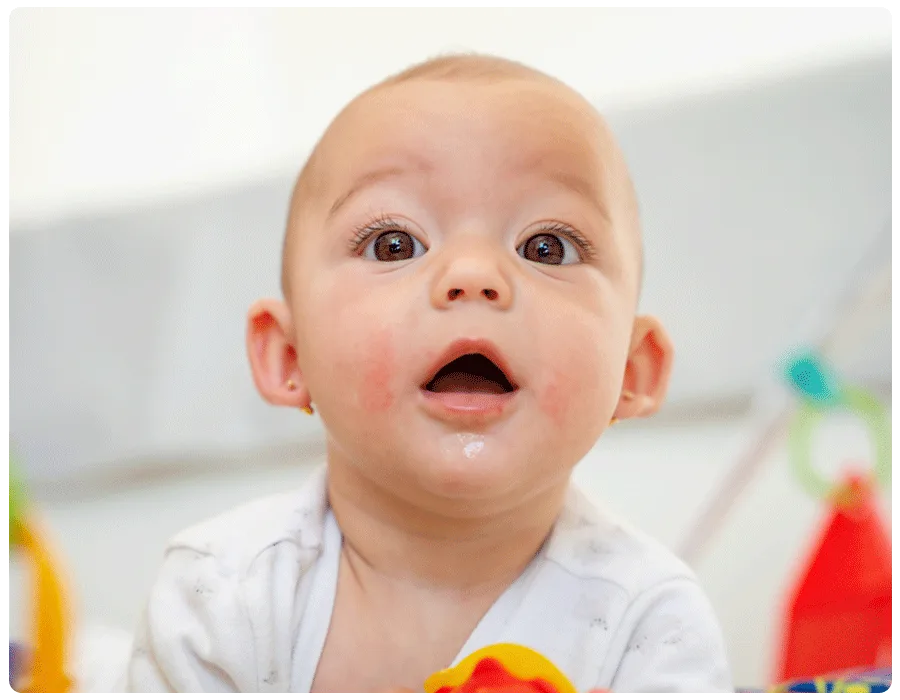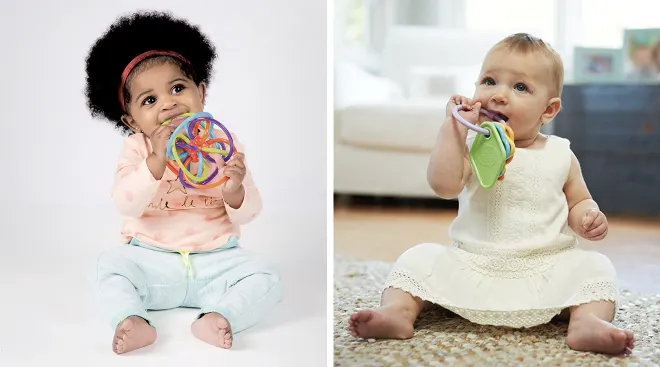What Is Drool Rash? and How to Treat It
At my youngest son’s first birthday party, he was sporting a head of platinum blond hair, an adorable bright red henley and a drool rash that was almost red enough to match his shirt. More than one partygoer peppered me with questions about the flaming splotches across his chin: “Does he have hives? Is that impetigo? Do you think he has eczema?”
No, I answered more than once—it’s just a drool rash. At 12 months, my son was cutting more than one tooth and he had the red, irritated skin under his mouth to show for it. Although he looked like he’d been struck down by some awful skin disease, a drool rash (also commonly called a teething rash) is mostly harmless and extremely common in young children—especially if they have sensitive skin.
If your baby or toddler is sprouting new teeth and has a similar rash under or around their mouth or chin, the two things are most likely related. Here’s what to know about a drool or teething rash, along with what you can do to prevent and treat it.
Drool rash is any type of skin irritation or contact dermatitis caused by drool or saliva. When drool comes into frequent contact with the skin, it can result in inflammation which leads to redness, dryness, or even a noticeable rash under or around the mouth and chin. Sometimes this is caused by teething, but not always; a baby’s salivary glands start working around 2 months of age, according to UCSF Benioff Children’s Hospitals, which can cause an increase in drool not related to teething.
Basically, a drool rash is related to baby’s overall growth and development, which includes teething but also age-related changes and their budding interest in solid foods. In fact, you may notice an increase in drool—and see the first signs of a drool rash—around the four-month mark, says pediatrician Ilan Shapiro, MD, FAAP, chief health correspondent and medical affairs officer for AltaMed Health Services; this is right around the time baby is getting ready to have something other than breast milk or formula.
“As infants grow, their body starts preparing to ingest solids,” says Shapiro, “and saliva is a crucial part of eating solids because it helps start the process of digestion and also helps make sure the food gets to our stomach.”
However, in order to help us break down foods, that saliva has to contain enzymes, including one called ptyalin. This can make saliva irritating to baby’s skin, and the excess amount of it produced at this stage can lead to drool rash and inflammation.
Is drool rash and teething rash the same?
Both terms refer to the same redness, irritation and inflammation around and under the mouth or chin caused by an increase in saliva. Teething rash is just a more specific term that places the blame on new teeth coming in rather than an increase in saliva caused by developmental changes as baby grows.
Early signs of drool rash often appear as dryness, says Shapiro, followed by red spots or patches. Drool rash can also look like:
- Chapped skin
- Flat or slightly raised patches
- Tiny reddish-colored bumps
- Flaking or scaling
- Itching
All of the skin around the mouth is fair game for a budding drool rash, and so are the cheeks, the chin and even the neck and upper chest (depending on just how much drool baby is making!).
Drool rash pictures
Below is an example of what a drool or teething rash might look like. Keep in mind it might be milder or more severe.
Drool rash treatment basically involves two steps, says Shapiro: keeping the skin dry and protecting it with a barrier cream.
Start by changing baby’s clothes and bibs when they’re soaked through, and making the best effort you can to remove saliva from their skin during the day. You won’t be able to keep them 100 percent dry all the time, especially if baby is drooling a lot! Just do what you can.
Be sure to pat their skin dry rather than rub or wipe it, because patting is much gentler on damaged skin. Also clean the affected areas with warm water after eating.
Meanwhile, invest in what’s called a barrier cream and get in the habit of applying it frequently throughout the day and before bedtime. Dr. Shapiro says products like petroleum jelly (Vaseline), Aquaphor and other types of heavy ointments create a barrier between saliva and baby’s skin, keeping it from drying out and protecting it from the harsh enzymes in saliva.
Optionally, you may want to switch to hypoallergenic baby soaps, lotions and laundry detergents, since these come into direct contact with baby’s skin and could contain irritating fragrances or other ingredients that worsen already-inflamed skin.
If this sounds a lot like the treatment for diaper rash, you’re not wrong: a frequently-wet bottom irritated by stool and urine is prone to rashes for similar reasons! Basically, parents with experience treating diaper rash can follow a similar protocol when treating drool rash.
You can try! Unfortunately, some kids will have a drool rash for most of the time they’re teething simply because their skin is more sensitive (and it’s hard to keep up with teething rash treatments when your child suddenly cuts four teeth in one week!).
Since one of the biggest causes of drool rash is the combination of wet, vulnerable skin and exposure to the enzymes in saliva, the main prevention strategy is to protect the skin before it becomes irritated.
You can do this by frequently applying one of those thick barrier creams, says Gina Posner, MD, pediatrician at MemorialCare Medical Group in Fountain Valley, California. This helps seal and protect baby’s skin.
While a drool rash is typically not harmful or complicated, damaged and inflamed skin is always more prone to infection than healthy skin.
“The moment there’s saliva on the skin, it can start breaking the barrier,” says Shapiro. “That barrier can be penetrated by bacteria and lead to an infection.”
Keep an eye out for any signs of crusting, weeping or oozing where your child has a drool rash; this could signal a bacterial infection, such as impetigo, or a fungal one, like candidiasis (yeast). Shapiro says any drool rash that looks infected or that simply doesn’t go away with at-home treatments should be evaluated by a healthcare professional.
Frequently Asked Questions
Does drool rash hurt?
Shapiro says drool rash is usually not painful, but an ongoing, chronic rash may be uncomfortable—plus, it can open the door to more painful infections and other skin problems in the future.
How long does drool rash typically last?
In general, drooling ramps up around 2 or 3 months of age, and is often the most noticeable through baby’s first six months. But since babies are teething well beyond that time, your child’s rash could last much longer. As long as there’s extra saliva in baby’s mouth, drool rashes are a very real possibility.
How can you distinguish between drool rash and hand, foot and mouth disease?
For one, a teething rash is only found around the mouth, says Posner, not on the palms of hands and soles of feet as is common with hand, foot and mouth disease. Plus, the oral symptoms of hand, foot, and mouth disease are usually internal too (sores and blisters inside the mouth, not on the skin surrounding the mouth). Hand, foot and mouth disease also typically causes a sore throat, fever and flu-like symptoms, notes the Centers for Disease Control and Prevention (CDC).
How can you distinguish between drool rash and eczema?
This is a bit trickier, since drool rash and eczema both commonly appear on the face in young children and share similar symptoms such as itchiness, redness and dryness. That said, eczema usually appears on other parts of the skin and not just around the mouth. A rash around the mouth that starts between the ages of 3 and 6 months, or is accompanied by other symptoms of teething, is more likely to be a drool rash.
Plus, more from The Bump:
Gina Posner, MD, is a pediatrician at MemorialCare Medical Group in Fountain Valley, California. She earned her medical degree from New York Medical College.
Ilan Shapiro, MD, FAAP, serves as chief health correspondent and medical affairs officer for AltaMed Health Services.
UCSF Benioff Children’s Hospital, Your Baby at 2 Months
American Academy of Pediatrics (AAP), Drooling and Your Baby, February 2016
Scripps Health, Baby’s Drool Rash: How to Treat and Prevent It, May 2024
Village Emergency Centers, Treating Drool Rash on a Baby’s Neck, November 2022
Merck Manual: Consumer Version, Overview of Bacterial Skin Infections, June 2023
Merck Manual: Consumer Version, Candidiasis (Yeast Infection), September 2023
Centers for Disease Control and Prevention, About Hand, Foot, and Mouth Disease
National Eczema Association, Causes, symptoms, treatment and more
Learn how we ensure the accuracy of our content through our editorial and medical review process.
Navigate forward to interact with the calendar and select a date. Press the question mark key to get the keyboard shortcuts for changing dates.






















































